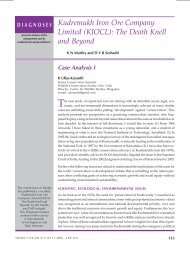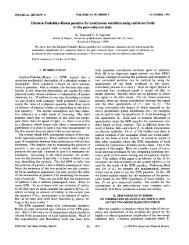Phase Transfer Catalysis - Publications of the IAS Fellows
Phase Transfer Catalysis - Publications of the IAS Fellows
Phase Transfer Catalysis - Publications of the IAS Fellows
You also want an ePaper? Increase the reach of your titles
YUMPU automatically turns print PDFs into web optimized ePapers that Google loves.
catalyst concentration during <strong>the</strong> cycle (see modeling studies<br />
later), one can perhaps consider it as a catalytic process with<br />
changing catalytic activity.<br />
The principle <strong>of</strong> PTC is based on <strong>the</strong> ability <strong>of</strong> certain<br />
“phase-transfer agents” (<strong>the</strong> PT catalysts) to facilitate <strong>the</strong><br />
transport <strong>of</strong> one reagent from one phase into ano<strong>the</strong>r (immiscible)<br />
phase wherein <strong>the</strong> o<strong>the</strong>r reagent exists. Thus, reaction<br />
is made possible by bringing toge<strong>the</strong>r <strong>the</strong> reagents which<br />
are originally in different phases. However, it is also necessary<br />
that <strong>the</strong> transferred species is in an active state for effective<br />
PT catalytic action, and that it is regenerated during <strong>the</strong><br />
organic reaction.<br />
Applications <strong>of</strong> PTC<br />
PTC finds applications in a variety <strong>of</strong> reactions. Primary<br />
applications are in nucleophilic substitution reactions and in<br />
reactions in <strong>the</strong> presence <strong>of</strong> bases involving <strong>the</strong> deprotonation<br />
<strong>of</strong> moderately and weakly acidic organic compounds. Reactions<br />
carried out using PTC include oxidations, reductions,<br />
polymerizations, transition metal co-catalyzed reactions, syn<strong>the</strong>sis<br />
<strong>of</strong> carbenes and fur<strong>the</strong>r reactions <strong>of</strong> carbenes, addition<br />
reactions, condensations, and so on, which are <strong>of</strong>ten part <strong>of</strong> a<br />
multistep syn<strong>the</strong>sis process for fine chemicals manufacture.<br />
In <strong>the</strong> base, mediated alkylation <strong>of</strong> weakly acidic organic<br />
compounds (PK~ m 15-24) PTC has made possible <strong>the</strong> use <strong>of</strong><br />
cheaper and easily available alternative raw materials like<br />
potassium carbonate and aqueous NaOH solution, <strong>the</strong>reby<br />
obviating <strong>the</strong> need <strong>of</strong> severe anhydrous conditions, expensive<br />
solvents, and dangerous bases such as metal hydrides and<br />
organometallic reagents. When <strong>the</strong>se reactions are carried out<br />
in <strong>the</strong> presence <strong>of</strong> a PT catalyst in biphasic systems, simple,<br />
cheap and mild bases like NaOH and K&O3 can be used<br />
instead <strong>of</strong> toxic alkali metal alkoxides, amides, and hydrides.<br />
For example, C-alkylation <strong>of</strong> active methylene compounds like<br />
activated benzylic nitriles, activated hydrocarbons, and activated<br />
ketones under PTC/OH- conditions has been pioneered<br />
by Makosza (1975, 1977), and is widely used in a large<br />
number <strong>of</strong> useful organic reactions. O<strong>the</strong>r advantages <strong>of</strong> <strong>the</strong>se<br />
reactions is an increased selectivity in some cases (Dehmlow,<br />
1995). For example, in carbene reactions in <strong>the</strong> presence <strong>of</strong><br />
50% NaOH, hydrolysis <strong>of</strong> <strong>the</strong> organic substrate is prevented<br />
due to phase separation.<br />
However, <strong>the</strong> main disadvantages <strong>of</strong> PTC, especially in<br />
commercial applications, is <strong>the</strong> need to separate <strong>the</strong> catalyst<br />
from <strong>the</strong> product organic phase. Some general separation<br />
techniques are discussed in <strong>the</strong> Conclusion Section. Ano<strong>the</strong>r<br />
method to overcome <strong>the</strong> problems associated with catalyst<br />
recovery is to immobilize <strong>the</strong> PTC on a solid support. This is<br />
discussed in <strong>the</strong> subsection on ultrasound in PTC systems.<br />
Objective <strong>of</strong> review<br />
It is estimated (Starks et al., 1994) that PTC is used in as<br />
many as 500 commercial processes, with sales <strong>of</strong> products<br />
manufactured by processes consisting <strong>of</strong> at least one major<br />
PTC step being at least $10 billion a year, with wide ranging<br />
applications in <strong>the</strong> pharmaceuticals, agro-based chemicals,<br />
and polymer industries.<br />
Despite thousands <strong>of</strong> publications on <strong>the</strong> chemistry and<br />
applications <strong>of</strong> PTC, an important yet surprisingly lacking link<br />
is a comprehensive kinetic study and ma<strong>the</strong>matical modeling<br />
AIChE Journal March 1998<br />
<strong>of</strong> PTC reactions. Engineering analysis is limited to a handful<br />
<strong>of</strong> articles on kinetics and modeling <strong>of</strong> <strong>the</strong>se reactions. Industrial<br />
applications <strong>of</strong> PTC are widespread but remain patented<br />
or well guarded secrets. Mere empirical knowledge that has<br />
guided much <strong>of</strong> industrial PTC process development is obviously<br />
not adequate for efficient and optimum development <strong>of</strong><br />
PTC technology.<br />
This article attempts to unify <strong>the</strong> vast literature on PTC<br />
chemistry with a comprehensive review <strong>of</strong> kinetic studies and<br />
ma<strong>the</strong>matical modeling <strong>of</strong> PTC systems, which necessarily involve<br />
<strong>the</strong> role <strong>of</strong> intraphase and interphase mass transport.<br />
This coupling <strong>of</strong> knowledge from chemistry with engineering<br />
should prove useful in developing rational methods <strong>of</strong> reactor<br />
design and scale-up for commercial PTC applications.<br />
Fundamentals <strong>of</strong> <strong>Phase</strong>-<strong>Transfer</strong> <strong>Catalysis</strong><br />
Clussification <strong>of</strong> PTC systems<br />
PTC reactions can be broadly classified into two main<br />
classes: soluble PTC and insoluble PTC (Figure 1). Within<br />
each class, depending on <strong>the</strong> actual phases involved, reactions<br />
are fur<strong>the</strong>r classified as liquid-liquid PTC (LLPTC),<br />
gas-liquid PTC (GLPTC), and solid-liquid PTC (SLPTC). In<br />
some cases, <strong>the</strong> PT catalyst forms a separate liquid phase,<br />
and this variant <strong>of</strong> PTC can be grouped along with traditional<br />
insoluble PTC, where <strong>the</strong> PT catalyst is immobilized on a<br />
solid support. O<strong>the</strong>r nontypical variants <strong>of</strong> PTC include inverse<br />
PTC (IPTC) and reverse PTC via a reverse transfer<br />
mechanism (Halpern et al., 1985).<br />
In LLPTC, <strong>the</strong> nucleophile (M+ Y- ) is dissolved in an<br />
aqueous phase, whereas in SLPTC it is a solid suspended in<br />
<strong>the</strong> organic phase. Traditionally, more applications <strong>of</strong> PTC<br />
have been reported in liquid-liquid systems, although <strong>the</strong>re is<br />
a distinct advantage in operating in <strong>the</strong> solid-liquid mode in<br />
some reactions since <strong>the</strong> elimination <strong>of</strong> <strong>the</strong> aqueous phase<br />
lowers <strong>the</strong> degree <strong>of</strong> hydration <strong>of</strong> <strong>the</strong> ion pair, leading to an<br />
increase in its reactivity. Thus, higher selectivities and yields<br />
are sometimes obtained by operating in <strong>the</strong> solid-liquid mode<br />
as compared to operation in <strong>the</strong> liquid-liquid (aqueousorganic)<br />
mode. For example, reaction <strong>of</strong> phenylacetylene with<br />
benzyl bromide in <strong>the</strong> presence <strong>of</strong> CO and NaOH with TDA-1<br />
as PT catalyst and a cobalt carbonyl complex as cocatalyst<br />
gives phenylacetic acid when operated as a liquid-liquid system<br />
due to rapid hydrolysis <strong>of</strong> <strong>the</strong> acylcobaltcarbonyl intermediate,<br />
whereas using solid NaOH gives <strong>the</strong> corresponding<br />
lactone (Arzoumanian and Petrignani, 1986). GLPTC involves<br />
<strong>the</strong> use <strong>of</strong> PTC in gas-liquid-solid systems, where <strong>the</strong><br />
organic substrate is in a gaseous form and is passed over a<br />
bed consisting <strong>of</strong> <strong>the</strong> inorganic reagent or some o<strong>the</strong>r solid<br />
reagent/cocatalyst (commonly, solid K$OJ in solid form<br />
(Tundo and Ventureho, 1979), or an inert inorganic support<br />
(Tundo et al., 1989; Tundo and Selva, 1995, and references<br />
<strong>the</strong>rein), both <strong>of</strong> which are coated with a PT catalyst in its<br />
molten state. Although, strictly, this is a gas-liquid-solid<br />
triphase system, it has traditionally been referred to as<br />
GLPTC. Advantages <strong>of</strong> GLPTC include ease <strong>of</strong> adaptation<br />
to continuous flow operation (with <strong>the</strong> gaseous reagents flowing<br />
continuously over <strong>the</strong> solid bed), absence <strong>of</strong> organic solvent<br />
since <strong>the</strong> organic substrate is present in gaseous form,<br />
ease <strong>of</strong> recovery <strong>of</strong> <strong>the</strong> PT catalyst as it is directly loaded<br />
Vol. 44, No. 3 613
















